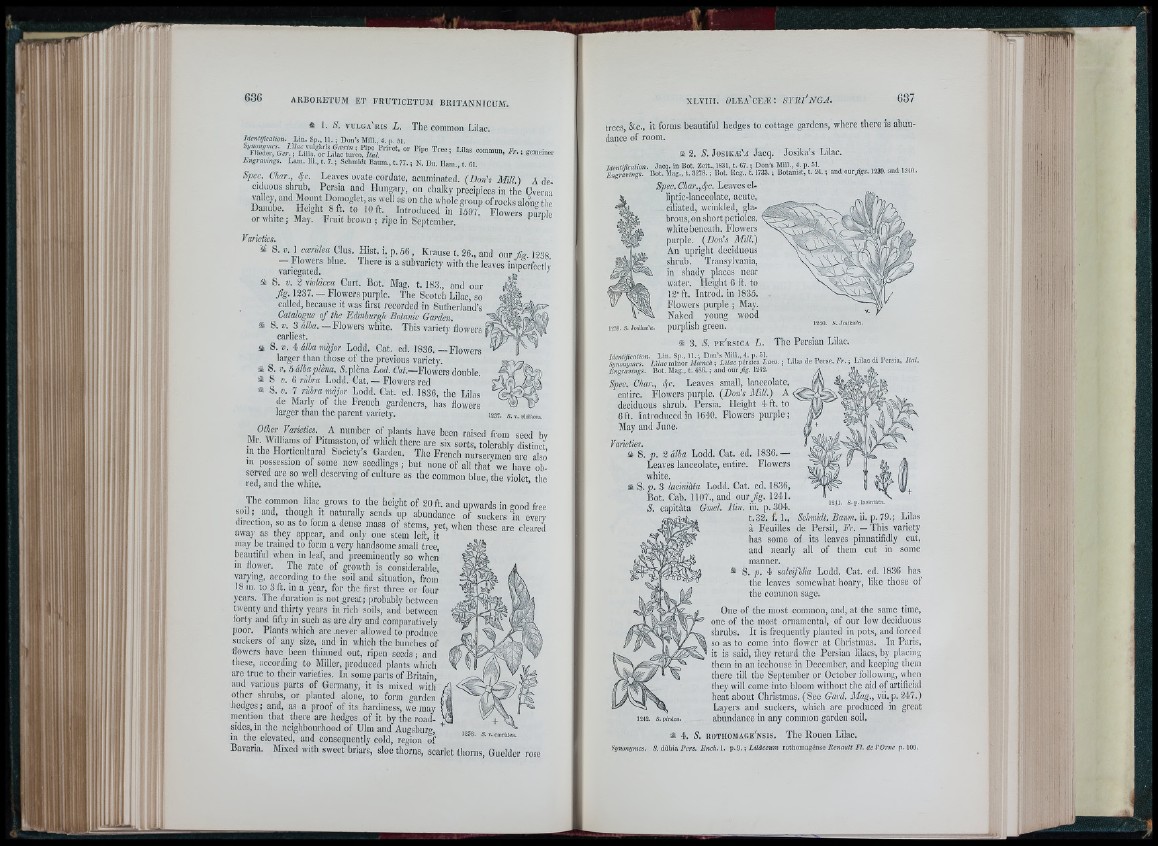
:l
Jdcntijìcation. Lin. Sp., IL ; Don’s Mill., 4. n. .Si.
” f r " - “ ■"»■»n, gemoincr
Fiigravmgs. Lam. Ili., t. 7. -, Schmidt Baum., t. 77. -, N. Du. Ham., t. 61,
Spec, d a r ., f r . Leaves ovate cordate, acuminated. (Dim’s M i/n i de
Ciduous shrub. Persia and Hungary, on chalky precipices in the Qrarni;
ralley, and M o n / Domoglet, as well as on the whole gi’oup of rocks alono tlie
Danube. Height 8 ft. to 10 ft. Introduced in 1597. Flowers ptmjle
or white; May. Fruit brown ; ripe in September.
Farieiic's.
* s .» . 1 cainifea Clus. Hist. i. p. 56 , Krause t. 26., and our fc . 1238
? r t e e ® r " subvariety with the leaves inipmfoctly
SÉ S. V. 2 via/àcea Curt. Bot. Mag. t. 183., and our
flg. 1237. — Flowers purple. The Scotch Lilac, so
called, because it was first recorded in Sutherland’s
Catalogue of the Edinburgh Botanic Garden.
* S. ». 3 alba. —Flowers white. This variety flowers t
earliest. '
3É S. ». 4 alba major Lodd. Cat. ed. 1836. — Flowers
larger than those of the previous variety.
3É 8. p. 5 alba pièna. A’, plena Lod. Cat.—Flowers double.
SÉ S ». 6 rubra Lodd. Cat. — Flowers red
2É S.». 7 riibra major Lodd. Cat. ed. 1836, the Lilas
de Marly of the French gardeners, has flowers
larger than the parent variety. 1237. .s. v. .loUc»..
bren raised from seed hv
Mra Williams / Pitcaaston, of winch there are six sorts, tolerably distinci
m the Horticultm-al Society’s C/rdon. The French nurserymen are alsi
m possession of some new seedlings ; but none of all that we have observed
are so well deserving of culture as the common blue, the violet the
red, and the white. ’
The common lilac grows to the height of 20 ft. and upwards in good free
soil; and, though it naturally sends up abundance of suckers in every
direction, / as to form a c ense mass of stems, yet. wlien these are cleared
away as they appear, and only one stem left, it
may be trained to form a very handsome small tree,
beautiful when in leaf, and preeminently so when
in flower. The rate of growth is considerable,
varying, according to the soil and situation, froni
18 in. to 3 ft. in a year, for the first throe or four
years. The duration is notyp-eai; probably between
twcnly and thirty years iiM-ich soils, and between
loity and fifty in such as are tlry and comparatively
|)oor. Plants which are .never allowed to produce
suckers of any size, and in which the bunches of
flowers have been thinned out, ripen seeds ; and
these, according to Miller, produced plants which
are true to their varieties. In some parts of Britain,
and various parts of Germany, it is mixed with
other shrubs, or planted alone, to form garden
hedges ; and, as a proof of its hardiness, we may
mention that there are hedges of it by the roadsides,
in the neighbourhood of Ulm and Augsburg, „
in the elevated, and consequently cold, region of '
Bavaria. Mixed with swect briars, sloe thorns, scarlet thorns, Guelder rose
ilia. Ü r
trees, &c., it forms beautiful hedges to cottage gardens, where there is abundance
iai9. s. Jositw'a
laiO. s. JosikiE'
The Persian Lilac.
of room.
at 2. S. JosiKiE'z4 Jacq. Josika’s Lilac.
T/L’nfificntion. Jacq. in Bot. Zeit., 1831, t. G7. ; Don’s Mill., 4. p. ril. , ,
Engravings. Bot. Mag., t. 3278. ; Bot. Reg., t. 1733. ; Botanist, t. 24. ; and our figs. 1239. and 1240.
Spec. Char.,S/C. Leaves el- '
liptic-lanceolate, acute,
ciliated, wrinkled, glabrous,
on short petioles,
white beneath. Flowers
purple. {Doris Mill.)
An upright deciduous
shrub. Transylvania,
in shady places near
water. Height 6 ft. to
12* ft. Introd. in 1835.
Flowers purple ; May.
Naked young wood
purplish green.
-afe 3 . S. p k ' r s ic a L.
1 LiUs dò Porse, Fr. ; Lilac dl Persia, lia,.
Éngravings. Bot. Mag., t. 48G. ; and o u r/g '. 1242. * •-
Spec. Char., c^c. Leaves small, lanceolate,
entire. Flowers puiqile. (Doris Mill.) A
deciduous shrub. Persia. Height 4 ft. to
6ft. Introducedin 1640. Flowers purple;
May and June.
Farietie.!.
úié S. p. 2 álba Lodd. Cat. cd. 1836.—
Leaves lanceolate, entire. Flowers
white.
Si S. p. 3 laciniàia Lodd. Cat. ed. 1 8 3 6 ,
Bot. Cab. 1107., and o u r /g . 1241.
S. capitàta Gmel. Hin. iii. p. 304.
1211. s. p. laclnifMa.
t.S2. f. 1., Schmidt. Baum.'ú. p .79.; Lilas
à Feuilles de Persil, Fr. — This variety
has some of its leaves pinnatifidly cut,
and nearly all of them cut in some
manner.
^ S. p. 4 salvifhlia Lodd. Cat. ed. 1 8 3 6 has
the leaves somewhat hoary, like those of
the common sage.
One of the most common, and, at the same time,
one of the most ornamental, of our low deciduous
shrubs. It is frequently planted in pots, and forced
so as to come into flower at Obri.stinas. In Paris,
it is said, they retard the Persian lilacs, by placing
them in an icehouse in December, and keeping them
there till the Se[)tember or October following, when
they will come into bloom without the aid of artificial
heat about Christmas. (See Gard. Mag., vii. p. 247.)
Layers and suckers, which are produced in great
abundance in any common garden soil.
1242. S. pérsica.
sk 4. S. r o t i io m a g e ' n s i s . The Rouen Lilac.
Synonyines. S. dClbia P its . Enck.X. /¡.ò. ; Lilàccum xotMamagiusc Renault Fl. de VOrne p. 100.
i l |i
'■ li- !!i
È m M '
i i i ? ? . ! ? ’-
U J